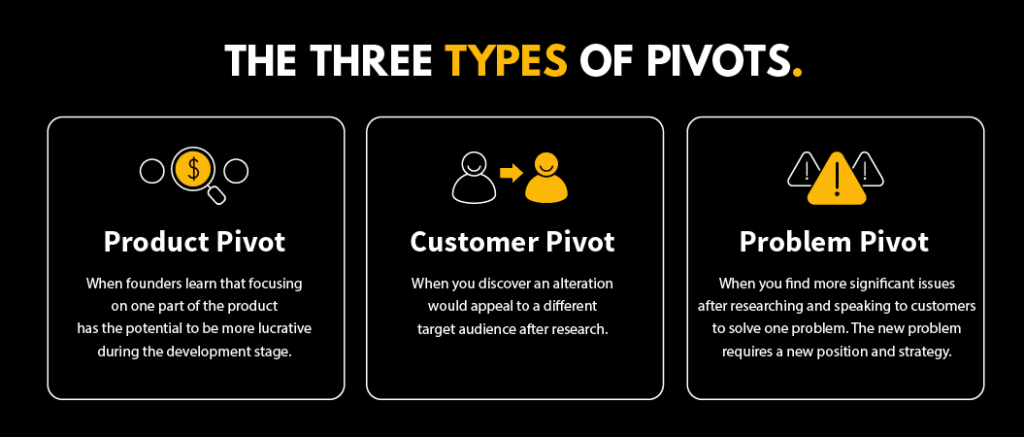A few years ago, my group launched a new venture.
We built an integrated search tool offering access to 24 document platforms, including Dropbox and Google Drive. Our product created a unique experience and solution for locating documents within many programs – users could find the information they were looking for in three clicks or fewer without using keywords.
When launching a startup, it is vital to keep analyzing the user experience, the market, and the product's success to determine if you are heading in the right direction.
Founders of the business must continue learning and make tactical changes as needed.
When an organization decides to pivot a product, it may realize that parts of the product are not doing as well as others. In most cases, the change of direction is due to faults in the original strategy.
In this article, you’ll learn about navigating the process for successful pivots: the reasons and different types of pivots, and the challenges and thought processes you face to change product strategies.
What Is a Minimum Viable Product?
Most fantastic ideas come from ideas and assumptions. Founders decide to launch a startup because they assume they have the best solution for a problem.
Startups are confident they will create a more effective product than competitors, and customers will pay for the solution they provide. Thus, collecting data through various avenues is critical. A minimum viable product (MVP) is an item that startups release to a select few people and limits features. They do this so the group can provide feedback and reviews crucial for product development. The idea is to prove and disprove your assumptions through various low-cost channels.
In our case, most users find documents by asking others to send them the link. That’s why we designed our product as a social network.
Users would log on and see the faces of the people they collaborated with on projects. It included individuals within and outside the organization. Our product allowed users to click on the person and see the documents they were working on or recently updated.
People loved it.
During a research session, we asked the CEO of a small startup to use the product and provide feedback.
Unfortunately, he found that he had access to documents that he should not have permission to access. The session led us to the conclusion that controlling access to the documents is a more significant pain than finding them.
At that point, we concluded it was time to change strategies and pivot.
The Three Types of Pivot
There are three main types of pivots to be aware of during product development. The category the pivot falls within will have a massive effect on the appropriate course of action.

Product Pivot
A product pivot occurs when founders learn that focusing on one part of the product has the potential to be more lucrative during the development stage.
After looking at the big picture, they conclude that zooming in on one feature is the best strategy. Another type of product pivot occurs when the designer finds they should create a completely alternate product after gaining knowledge from reviewing customer usage data.
Customer Pivot
A customer pivot occurs when you discover an alteration would appeal to a different target audience after research. They can also happen when the customer's preferences or requirements change.
Problem Pivot
A problem pivot comes to light when you find more significant issues after researching and speaking to customers to solve one problem. The new problem will require a new position and strategy. Changing direction and pivoting in this situation is a stimulating experience.
In my case, a customer pivot brought the problem to our attention. But it came down to a product pivot.
Pivot vs. Hop
It is important to remember that deciding to change startup direction is a hop, not a pivot.
Startups changing directions is not a bad thing. Yet, changing the startup's focus randomly when it has nothing to do with the first goal is not a pivot. Startup founders hop from one idea to another rather than choosing to pivot after learning new information from research and customers.
We base pivots on learning from extensive research and data accumulation. A hop occurs out of necessity or an opinion.
Many use Slack as an example of a successful pivot, but it was a hop.
The founder's focus for the startup centered around building games. Later, they decided they didn't want to do that anymore and hopped to the version of Slack we know today.
When startups grow tired of one direction, they hop to another. If your research and learning new data causes you to change direction, that is a pivot.
How To Know When it's Time To Pivot
Deciding when to pivot or stay the course is a challenging process. It is difficult for startup founders worldwide. Choosing to pivot prematurely without enough research and evidence can mean missing opportunities. Waiting too long to pivot can mean wasting time and resources on a product that does not deliver.
After you research and collect data that shows restructuring might be necessary, you must understand when the tipping point occurs.
When an idea has slow progression despite putting in the work, or you're getting negative feedback from customers, it’s time to consider a pivot.
People often review customer feedback and conclude that problems are not significant enough to change direction. The bottom line is that when the direction you are going does not have the potential to be as lucrative as another route, it is time to pivot.
- Consider whether turning one feature or part of the product is a better direction for the startup.
- There are also times that startups find that the product should be one feature of a much larger product.
- Research various groups of customers across a wide range of markets and consider all the data from different points of view.
- Pivots are challenging and risky, and you should only consider them if they will increase the chance of success significantly or save the business.
While countless startups have massive success after a pivot, some new founders attempt to pivot when it is unnecessary. Unneeded pivots can do more harm than good.
How to Successfully Pivot a Product
The first step to successfully pivoting a product is to accept that there are problems with your product.
Founders must be determined and act quickly.
The pivot may require you to change every part of the strategy. A pivot requires substantial research, planning, and execution. A lot more energy goes into the process than most entrepreneurs understand.
When startups pivot, they shift to a new and more lucrative strategy. It does not always mean they must change the entire direction of the business. In many cases, founders can address one substantial problem and alter the company's approach.
How to Counter the Pain of Attachment During a Pivot
It's common for entrepreneurs who successfully pivot to wish they'd changed direction earlier. Many factors hold them back, including the pain of attachment.
Deciding whether to continue with the current idea and plan or restructure and change parts of a product is one of the most challenging company leaders make. One thing that makes it difficult is that there is not usually a complete failure.
It is common to feel attached to the current direction, and changing course can be painful.
Listening to what customers say about the project can be uncomfortable when the feedback isn't positive. People often think they are good at change. Yet, pivoting is often painful because people fear change naturally. During these times, listening to the customer's critique and exploring other options is critical. Counter the pain of attachment and fight to see it from their perspective.
How To Use Your Fears To Fuel Growth
Collecting negative customer feedback and finding unfavorable data can often be emotional and induce distress. That is the most crucial time to dig deep and use your fears for growth.
Advances and progress most commonly occur when you push yourself to face fears. Failing to continue when you're scared will hinder the startup's success, while a growth mindset leads to action, changes, and success.
Things got intense when we began to change strategies for a pivot, and I loved the entire process. As the saying goes, the scariest and most complicated path is usually the right direction and will bring the most growth and success.









